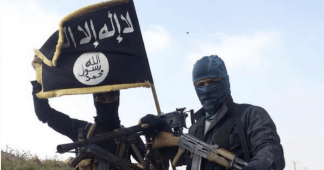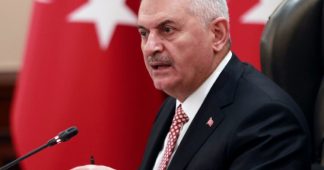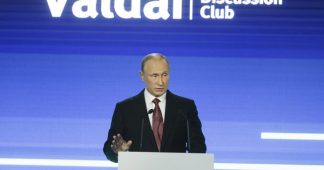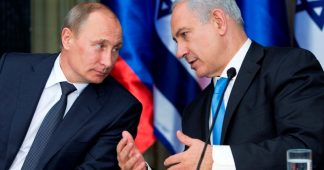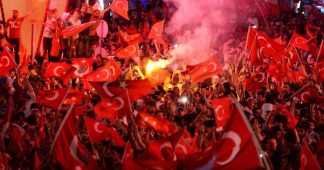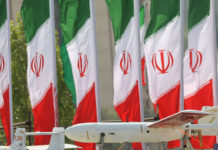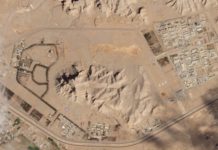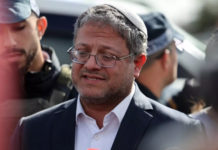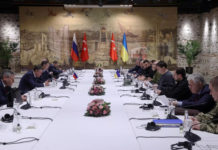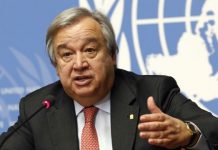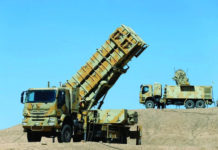First Published at September 25, 2014
One of the points I consistently try to get across in my writings and talks is that international terrorism is a good deal more complicated than most portrayals of it would have you believe. In many movies — and official presentations too, since governments often leave interesting details out of what they tell the public — there’s a shadowy group of bad guys bent on blowing something up, and it’s up to the good guys (cops and/or spooks) to stop them before they kill. Sometimes the case really is as simple as the Official Narrative portrays it, but often it’s not.
A couple days ago I explained how a terrorist group in Turkey called Tawhid-Salam, which is behind several attacks and assassinations in recent years, is really a wholly owned subsidiary of Iranian intelligence. It serves as a cut-out for the notorious Pasdaran, Iran’s Revolutionary Guards Corps, which is recognized by the U.S. Government as a terrorist group. What makes this particularly troubling is that Tawhid-Salam has evaded close scrutiny for years because top Turkish officials are in bed with Tehran.
My piece was met with a certain degree of incredulity. Would revolutionary Shia Iran really support Sunni terrorists? Yes, Tehran certainly would — and does. The Pasdaran has been backing Sunni jihadists, including Al-Qa’ida (AQ), since at least the beginning of the 1990’s, as my writings on Bosnia, which are based on reliable intelligence, have demonstrated. Certainly there has been a detectable relationship between Tehran and “AQ Central” since 1996 at least, a fact which is well known to intelligence services worldwide.
Yet most journalists and a distressing number of “terrorism experts” ignore such matters. One happy by-product of the current American-led war on the Islamic State is that some people are now more willing to state that Iran does in fact possess ties to various terrorist groups, among them AQ and the Islamic State. Yet it’s still a struggle to get many people to see what’s obvious here.
Part of this willful disbelief is due to simple ignorance. Most “terrorism experts,” and virtually all of them possessing academic credentials, have exactly zero personal interaction with operational counterterrorism; therefore they are ignorant of the fact that many intelligence services — and all of them in the Middle East — play a wide range of operational games with terrorist groups, AQ very much included, encompassing everything from placing agents inside terror cells to actually creating terrorist fronts like Tawhid-Salam.
Yet much of their ignorance is intentional, since there is ample open-source information demonstrating that the actual backstory of many terrorist groups is murky and messy. The Official Narrative peddled by virtually every talking head on television or mainstream op-ed writer omits important details, particularly the clandestine interaction of states with terrorists. There is no “it’s complicated” button in counterterrorism studies, but there ought to be.
This dirty complexity deters most “terrorism experts,” since it quickly leads to awkward questions about what’s really going on behind news reports of bombings and murders. Academics especially like things to be simple and preferably numeric. Here the dominance of social scientists in terrorism studies has played a pernicious role, since they want clean numbers upon which to work their statistical magic. Big Data is all the rage among academics working in counterterrorism, yet it seems to never occur to what I term the Credulous Number-Crunching Brigade that their data may be junk.
I’ve taken Brigade members to task over this, but the plain truth is that most academics simply ignore things that may contradict their assumptions about the reality of international terrorism. I’m not talking about professors who play fast and loose with numbers — academia is as prone to fantasy fads as anywhere — but those who simply avert eyes when discussion of real-world provocation and what I’ve called Fake Terrorism comes up. They don’t want to know.
This is particularly troubling because many of these “terrorism experts” are taken seriously by governments and are treated like rock stars in the Pentagon and other halls of power, even when their work is deeply flawed by its omission of fundamental realities. This aversion to complex questions that may have messy answers does not serve the cause of defeating terrorism.
As a result, critical questions about which governments are secretly collaborating with AQ and Salafi jihadists, and to what degree, tend to never even get asked, much less answered. To even bring them up is to invite ridicule, amid whispers of “conspiracy theories.” This leads to a strange, faculty-lounge-friendly universe of imagination that bears little resemblance to what the problem of international terrorism actually is.
A classic example of this came a few years back when I was sitting through a presentation on Salafi jihadism by a noted expert, someone who has appeared regularly in the media. Let me state that he’s a smart guy who has crunched a great many numbers and much of his presentation was interesting and relevant. The jaw-dropper arrived when he put up a slide — counterterrorism is as fueled by PowerPoint as everything else that touches the Department of Defense or the Intelligence Community — showing 1995 as the year with the greatest number of AQ terrorist attacks on the West.
In a very technical sense, this was a true statement, since that year did indeed witness an unusually large number of attacks by AQ-linked terrorists in Europe; several bombings in Paris by Algerians of the Armed Islamic Group (GIA) bolstered the numbers. However, the real story of the 1995 Paris bombings is one of the murkiest of all terrorism sagas in recent memory.
The Official Narrative is straightforward enough: GIA was using France, which has a large Algerian diaspora, as a major base for fund-raising and recruitment for their jihad against the Algerian regime, and a cell of operatives led by one Ali Touchent went off the rails and conducted seven bombings between late July and mid-October 1995, most famously attacking the Paris Metro, which altogether killed eight and wounded 157 civilians.
Paris was in panic mode after the bombings, and the terror cell was mostly rounded up by French authorities, being sentenced to long prison terms, save two members, one of whom went out in a blaze of glory. The other terrorist who evaded capture was Ali Touchent, the ringleader, who escaped the dragnet via GIA ratlines and apparently returned to Algeria. What became of this mystery man is difficult to answer with certainty — Algiers proclaimed his death more than once — but there is no doubt that Algerian intelligence, the military’s feared Department of Intelligence and Security (DRS), missed several chances to arrest Touchent, which may have something to do with the fact that the terror mastermind turned out to have close family connections to the DRS.
Hence there is a real question of who actually bombed Paris in 1995. Senior Algerian officials have admitted personal knowledge that Touchent was really a DRS agent provocateur, while top French intelligence officials have stated the same — and that Paris knew at the time that Algiers was actually behind the terror wave. The DRS manipulated GIA terrorists to conduct a series of bombings in France, an operation led by Ali Touchent, known as Tarek in the jihadist underworld, and this is something that jihadists close to the bombings likewise figured out.
Why the Algerian junta would bomb Paris via jihadist cut-outs is debatable, although DRS officials have stated that Algiers was feeling diplomatic pressure from France to take part in negotiations to end the country’s ugly civil war, which was entering its bloodiest phase. Paris was aware of the extent to which its Algerian partner was employing mass violence to defeat the Islamists and was troubled by the bloodshed. But the powerful DRS, which serves as the backbone of the military regime in Algiers to this day, was in no mood to negotiate with terrorists and wanted Paris to back off. The bombings achieved this, and French intelligence officials got the message and dropped talk of a negotiated settlement of Algeria’s civil war, which the regime effectively won in the latter half of the 1990’s by crushing GIA.
In contrast, there is ample evidence that the DRS deeply manipulated GIA from the outset, employing a strategy of penetration and provocation that Algerian spies learned from KGB instructors, the Russians having invented and perfected this dark art. This approach, while morally repugnant, proved highly effective at defeating the jihadists. By encouraging GIA to employ repulsive methods, above all embracing a violent takfiri tendency that led to the deaths of tens of thousands of Algerian civilians, the junta drove the jihadist movement into the ground and undermined the Islamist message.
GIA’s takfiri tactics, which included massacres of civilians by the hundreds, became so noxious that AQ broke ties with the group in 1997. Abu Musab al-Suri, perhaps the wisest strategist that the Salafi jihad movement has produced, worked closely with GIA and he realized that they had been deeply penetrated by Algerian intelligence, which was manipulating the group to murder innocents.
I have written about how the DRS defeated GIA with these ugly yet effective clandestine methods, making statements that are uncontroversial to most Algerians, who are well aware of how their country functions, only to meet skepticism from Western “terrorism experts,” who seem content to ignore mountains of evidence about what was really going on behind the scenes in Algeria’s civil war. Most academics will not acknowledge what Al-Qa’ida figured out about GIA almost twenty years ago.
At times, I have been tempted to conclude that fictional depictions of terrorism are sometimes more accurate than scholarly treatments of the problem. Yet, even then, many “experts” seem to miss the obvious. After 9/11, Joseph Conrad’s 1907 novel The Secret Agent enjoyed a brief fad as a “must-read” for insights into terrorism and the murderer’s mindset. No less than geo-strategy guru Robert Kaplan praised its “surgical insight into the mechanics of terrorism.” Conrad’s book can plausibly claim to be the first novel about terrorism (and one of the first spy novels), and I heartily endorse it.
However, those who encouraged everyone to pick up The Secret Agent to understand terrorism completely missed the point, as Conrad’s book is not about terrorism but fake terrorism. It’s unintentionally revealing that Western “terrorism experts” have plugged a novel that actually details how Russian intelligence used agents provocateurs masquerading as terrorists to discredit real terrorists over a century ago (which, in fact, the Tsar’s agents did frequently). Conrad, a Pole born Józef Korzeniowski in what is today Ukraine, was well acquainted with Russian secret methods, including what they call provokatsiya, his father having been imprisoned by the Tsar’s secret police for his Polish nationalist activism.
Really understanding terrorism is of more than academic interest as the West confronts a long-term war against Salafi jihadism. Obama came into office in no small part due to hopes from many Americans that the Bush-era Global War on Terrorism could be ended. But the enemy invariably gets a vote, and the rise of the Islamic State means that we face a protracted struggle against Salafi jihadism on many fronts. Even if Western governments, above all America’s, were to immediately embrace the unconventional strategy which I have proposed to defeat the enemy (see here and here), lasting victory over the jihadists is decades, not years off.
But a necessary first step is acknowledging that international terrorism is a good deal more complex than talking heads would have you believe. “Terrorism experts” in the academy and think-tankdom are hardly unique in their myopia — as I’ve noted, quite a few bookish “experts” in other fields basically have no idea what they’re talking about — but their unwillingness to dig deeply into the influence of states and intelligence services on terrorist groups means that the public is being misinformed and governments are getting bad advice. We no longer have the luxury of averting eyes, as the Salafi jihadist threat to the West is real and rising.
The appearance of the Islamic State as a major force in Iraq and Syria, with threats of terrorist attacks on the West, has concentrated minds again to a degree. But unwillingness to ask difficult questions persists in many quarters. Despite the fact that we have more than circumstantial evidence that the Islamic State is being manipulated by Syrian intelligence, and Iran’s too, these notions are dismissed out of hand by too many Westerners who study terrorism. Yet if we want to defeat the Islamic State, it would be wise to actually understand it. That Washington, DC, continues its bipartisan blocking of release of the full 9/11 Commission Report, which includes troubling details of Saudi misconduct regarding Al-Qa’ida, is not an encouraging sign.
This week we have yet another appalling beheading by terrorists linked to the Islamic State, this time the victim was a French tourist in Algeria. Given that the Islamic State has been cast out of the Al-Qa’ida family for its takfiri ways, including mass murdering of civilians — just as GIA was in 1997 — any serious analyst should be asking questions about what is really going on here, particularly given Algeria’s murky counterterrorism track record. Don’t let the Credulous Number-Crunching Brigade win, the stakes are too high.
